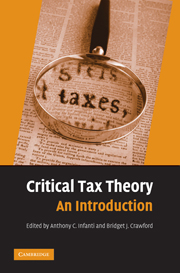Book contents
- Frontmatter
- Contents
- List of Illustrations
- List of Tables
- List of Contributors
- List of Common Abbreviations
- Introduction
- CHAPTER 1 FOUNDATIONS OF CRITICAL TAX THEORY
- CHAPTER 2 HISTORICAL PERSPECTIVES ON TAXATION
- CHAPTER 3 THE GOALS OF TAX POLICY
- CHAPTER 4 CRITICAL TAX THEORY MEETS PRACTICE
- CHAPTER 5 RACE AND TAXATION
- CHAPTER 6 GENDER AND TAXATION
- CHAPTER 7 SEXUAL ORIENTATION AND TAXATION
- CHAPTER 8 THE FAMILY AND TAXATION
- CHAPTER 9 CLASS AND TAXATION
- CHAPTER 10 DISABILITY AND TAXATION
- CHAPTER 11 GLOBAL CRITICAL PERSPECTIVES ON TAXATION
- CHAPTER 12 CRITICAL PERSPECTIVES ON CRITICAL TAX THEORY
- Redistributive Justice and Cultural Feminism
- Taking Critical Tax Theory Seriously
- A Feminist Perspective on the QTIP Trust and the Unlimited Marital Deduction
- Caring Enough: Sex Roles, Work, and Taxing Women
- Index
Caring Enough: Sex Roles, Work, and Taxing Women
Published online by Cambridge University Press: 04 August 2010
- Frontmatter
- Contents
- List of Illustrations
- List of Tables
- List of Contributors
- List of Common Abbreviations
- Introduction
- CHAPTER 1 FOUNDATIONS OF CRITICAL TAX THEORY
- CHAPTER 2 HISTORICAL PERSPECTIVES ON TAXATION
- CHAPTER 3 THE GOALS OF TAX POLICY
- CHAPTER 4 CRITICAL TAX THEORY MEETS PRACTICE
- CHAPTER 5 RACE AND TAXATION
- CHAPTER 6 GENDER AND TAXATION
- CHAPTER 7 SEXUAL ORIENTATION AND TAXATION
- CHAPTER 8 THE FAMILY AND TAXATION
- CHAPTER 9 CLASS AND TAXATION
- CHAPTER 10 DISABILITY AND TAXATION
- CHAPTER 11 GLOBAL CRITICAL PERSPECTIVES ON TAXATION
- CHAPTER 12 CRITICAL PERSPECTIVES ON CRITICAL TAX THEORY
- Redistributive Justice and Cultural Feminism
- Taking Critical Tax Theory Seriously
- A Feminist Perspective on the QTIP Trust and the Unlimited Marital Deduction
- Caring Enough: Sex Roles, Work, and Taxing Women
- Index
Summary
The triumph of the modern feminist movement in Western society over the past thirty-odd years is unprecedented in human history. Although feminism has had many important effects on a range of social practices, the story of its march is, at its core, the story of large numbers of women for the first time being permitted to engage in activities and occupy social roles formerly reserved to men. This change postdates, but itself completely coincides with[,] a development associated with modernity – the creation of modern labor markets. In the wake of feminism, those markets have seen the steady demise of practices that prevented women from offering, or employers from accepting, women's and men's labor on the same terms.
Without giving a full account of how and why these changes occurred, it is sufficient to say that traditional sex role norms have suffered grievously in recent years. Although powerful conventions and expectations still underwrite pronounced occupational segregation in partial disregard of talent or preference, the range of jobs open to women has dramatically expanded. Men and women are now closer to occupying a unitary labor market than ever before, with the consequence that competition for women's labor is keener than in the past. Women's pay is rising and approaching parity with that of similarly qualified men. As a result, the opportunity costs of alternative allocations of time and effort in the unpaid domestic sphere have never been greater. For well-educated women, the payoffs forgone by choosing to work at home are large.
- Type
- Chapter
- Information
- Critical Tax TheoryAn Introduction, pp. 385 - 388Publisher: Cambridge University PressPrint publication year: 2009



